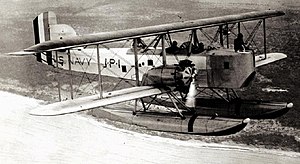The Douglas T2D was an American twin-engined torpedo bomber contracted by the military, and required to be usable on wheels or floats, and operating from aircraft carriers. It was the first twin-engined aircraft to be operated from an aircraft carrier.[1]
| T2D | |
|---|---|

| |
| Douglas T2D-1 of VP-1 | |
| Role | Torpedo bomber |
| Manufacturer | Douglas Aircraft Company |
| First flight | 27 January 1927 |
| Introduction | 1927 |
| Retired | 1937 |
| Primary user | United States Navy |
| Number built | 31 |
In 1925, the United States Navy's Bureau of Aeronautics designed a twin-engined torpedo bomber aircraft, intended to have greater performance than contemporary single-engined aircraft.[1] A single prototype was built by the Naval Aircraft Factory as the XTN-1, which was quickly followed by three identical aircraft built by Douglas, the T2D-1.
The XTN/T2D was a large two bay biplane, capable of easy conversion between floats and wheels, and carrying a crew of four.
The first three T2D-1's were delivered to the torpedo bomber squadron VT-2 on 25 May 1927,[1] being used for successful trials aboard the aircraft carrier Langley. A further nine T2D-1's were ordered in 1927, these normally being operated as floatplanes, partly owing to criticism from the Army of the Navy operating large land-based bombers,[1] and partly as its large size prevented Langley from embarking a full airwing.[2]
A further 18 aircraft were ordered in June 1930 as patrol floatplanes, being designated P2D-1. These were operated by Patrol Squadron VP-3 in the Panama Canal Zone until they were replaced by Consolidated PBYs in 1937.[1]
Data from McDonnell Douglas aircraft since 1920 : Volume I[3]
General characteristics
Performance
Armament